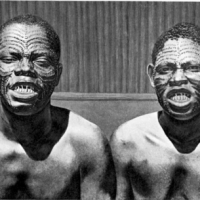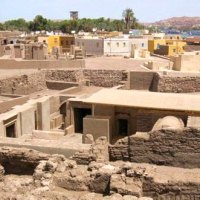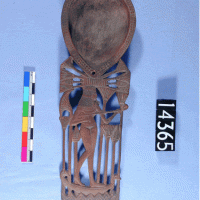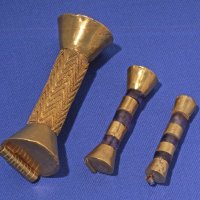Following his trip to Sumatra [described below] Park traveled to west Africa under the tutelage of the Africa Association, which was keen to obtain more information on the river Niger and groups inhabiting the area.

Transactions of the Linnean Society, Vol.3, in which Park describes his field trip in Sumatra and description of new fish. Source – The Linnean Society, Vol.3 –

Park’s first scientific trip was to Sumatra where he described and drew pictures of eight new fish. Source – The Linnean Society, Vol.3
Park’s love of travel had no doubt been stimulated by his voyage to Sumatra; thereafter, Sir Joseph Banks assisted in facilitating his expedition to west Africa supported by the Africa Association. In this endeavor, Park sought to scientifically detail local activities :
In researches of this kind, and in observing the manners and customs of the natives, in a country so little known to the nations of Europe, and furnished with so many striking and uncommon objects of nature, my time [recovering from sickness] passed not unpleasantly, and I began to flatter myself that I had escaped the fever, or seasoning, to which Europeans, on their first arrival in hot climates, are generally subject.
My recovery was very slow, but I embraced every short interval of convalescence to walk out, and make myself acquainted with the productions of the country.
… The grains which are chiefly cultivated are—Indian corn (zea mays); two kinds of holcus spicatus, called by the natives soono and sanio; holcus niger, and holcus bicolor, the former of which they have named bassi woolima, and the latter bassiqui. These, together with rice, are raised in considerable quantities; besides which, the inhabitants in the vicinity of the towns and villages have gardens which produce onions, calavances, yams, cassavi, ground nuts, pompions, gourds, water-melons, and some other esculent plants.
I observed likewise, near the towns, small patches of cotton and indigo. The former of these articles supplies them with clothing, and with the latter they dye their cloth of an excellent blue colour, in a manner that will hereafter be described.
In preparing their corn for food, the natives use a large wooden mortar called a paloon, in which they bruise the seed until it parts with the outer covering, or husk, which is then separated from the clean corn by exposing it to the wind, nearly in the same manner as wheat is cleared from the chaff in England.
The corn thus freed from the husk is returned to the mortar and beaten into meal, which is dressed variously in different countries; but the most common preparation of it among the nations of the Gambia is a sort of pudding which they call kouskous.
It is made by first moistening the flour with water, and then stirring and shaking it about in a large calabash, or gourd, till it adheres together in small granules resembling sago. It is then put into an earthen pot, whose bottom is perforated with a number of small holes; and this pot being placed upon another, the two vessels are luted together either with a paste of meal and water, or with cows’ dung, and placed upon the fire.
In the lower vessel is commonly some animal food and water, the steam or vapour of which ascends through the perforations in the bottom of the upper vessel, and softens and the kouskous, which is very much esteemed throughout all the countries that I visited. I am informed that the same manner of preparing flour is very generally used on the Barbary coast, and that the dish so prepared is there called by the same name. It is therefore probable that the negroes borrowed the practice from the Moors.
Their domestic animals are nearly the same as in Europe. Swine are found in the woods, but their flesh is not esteemed. Probably the marked abhorrence in which this animal is held by the votaries of Mohammed has spread itself among the pagans. Poultry of all kinds, the turkey excepted, is everywhere to be had. The guinea-fowl and red partridge abound in the fields, and the woods furnish a small species of antelope, of which the venison is highly and deservedly prized.
On the 23rd we departed from Jillifrey, and proceeded to Vintain, a town situated about two miles up a creek on the southern side of the river. This place is much resorted to by Europeans on account of the great quantities of beeswax which are brought hither for sale; the wax is collected in the woods by the Feloops, a wild and unsociable race of people:
Their country, which is of considerable extent, abounds in rice; and the natives supply the traders, both on the Gambia and Cassamansa rivers, with that article, and also with goats and poultry, on very reasonable terms. The honey which they collect is chiefly used by themselves in making a strong intoxicating liquor, much the same as the mead which is produced from honey in Great Britain.
In their traffic with Europeans, the Feloops generally employ a factor or agent of the Mandingo nation, who speaks a little English, and is acquainted with the trade of the river. This broker makes the bargain; and, with the connivance of the European, receives a certain part only of the payment, which he gives to his employer as the whole; the remainder (which is very truly called the cheating money) he receives when the Feloop is gone, and appropriates to himself as a reward for his trouble.
The language of the Feloops is appropriate and peculiar; and as their trade is chiefly conducted, as hath been observed, by Mandingoes, the Europeans have no inducement to learn it.
Source- Park, Travels in the Interior of Africa, vol.1 of 2. 1795, first publishing.
On an assessment of local people Park stated that:
Whatever difference there is between the negro and European, in the conformation of the nose, and the colour of the skin, there is none in the genuine sympathies and characteristic feelings of our common nature.
As for slaves, he comments:
They were all very inquisitive, but they viewed me at first with looks of horror, and repeatedly asked if my countrymen were cannibals. They were very desirous to know what became of the slaves after they had crossed the salt water. I told them that they were employed in cultivating the land; but they would not believe me …
A deeply-rooted idea that the whites purchase negroes for the purpose of devouring them, or of selling them to others that they may be devoured hereafter, naturally makes the slaves contemplate a journey towards the coast with great terror, insomuch that the slatees are forced to keep them constantly in irons, and watch them very closely, to prevent their escape…
Source – Wiki-Mungo Park [explorer]
However, we will see in a later entrée how Park deviated from attempts to retain an objective view in describing local people and groups, and why.




























